From the introduction: I love to teach. Among the more noble reasons, it makes me a better player. Sometimes I selfishly get to bounce new ideas and techniques off my students, hoping they will find their own way in the process. The content in my previous books, Voicing Modes, Modal Etudes, and The 4-Note Universe, tends to emphasize original thought and creativity rather than fulfilling the typical expectations of what students need in terms of essential skills. This fact became even more obvious to me when a student once told me in his first lesson, “I want to find the holes in my playing.” As he was already a fine musician without any obvious shortcomings, his desire to fill any gaps, I thought, was very wise. Even though he was asking for my opinion, the answer lies not really in my perspective but in a universal truth: the fundamentals. If you ask 100 guitarists to define the “fundamentals” of playing, you’ll likely hear 100 unique answers. To me, fundamentals are the essential tools you wield to give confidence and conviction to your musical ideas. Every guitarist has their own toolkit, shaped by their experiences and mastery of different techniques. The tools at your immediate disposal define how effortlessly you can express yourself through music. Sometimes, our limitations define our sound as we lean into our strengths; however, this can lead to frustration down the road. The mastery and consistent practice of fundamentals makes everything else easier. One of the most successful college basketball coaches, John Wooden, was meticulous about teaching fundamentals. In his book Practical Modern Basketball, he stated, “The team that has the best command of the fundamentals—passing, catching, dribbling, shooting, and defense—will usually win.” Another successful coach, Tom Crean, said, “Game plans win games. Fundamentals win championships.” With Creative Fundamentals, my goal is to systematically equip you with the raw skills needed to become a versatile, well-rounded guitarist (with examples for application along the way via compositions and etudes). Through a blend of pure technical exercises for your hands, ear-hand coordination to sharpen your musical intuition, eye-hand coordination to navigate both the visual symbols of music and the fretboard’s symmetry with precision, and mind-hand coordination to unlock the creative potential that analysis can provide, this book offers both the knowledge and a clear game plan. Whether you’re a beginner or a seasoned player, these exercises will help you identify your weaknesses, build a strong foundation, and expand your ability to make music with confidence and conviction. Practicing fundamentals doesn’t have to be mundane. In this book, I share creative approaches to mastering essential skills, transforming routine practice into ideas for composition. By thinking like a composer, you’ll learn to weave technical proficiency into musical ideas that turn the routine into something fun and interesting. My hope is that Creative Fundamentals not only fills the gaps in your playing but also sparks new ways to express your unique voice as a musician. Throughout this book, I’ll try to help you master the fundamentals not just in terms of technique, but how to access that technique: by ear, by eye and by mind. ----
Creative Guitar Fundamentals
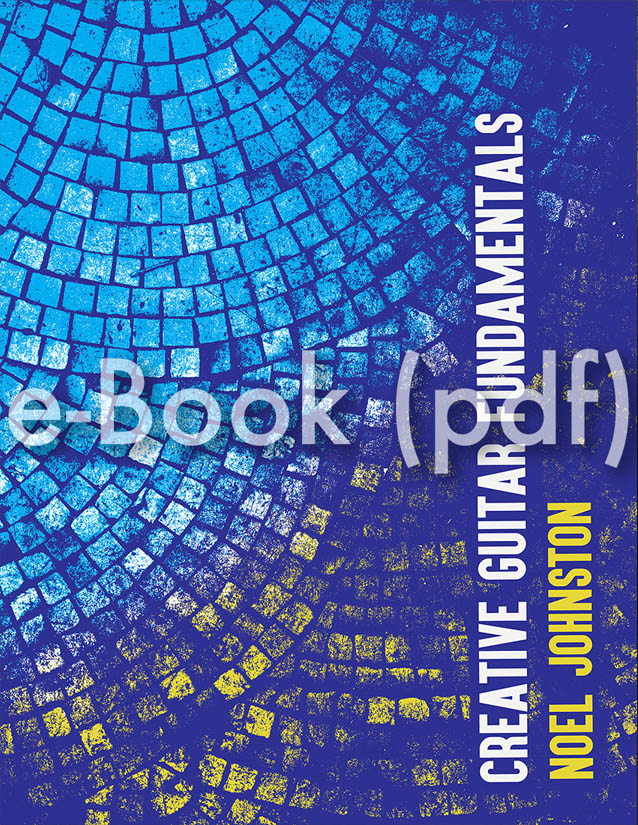
"NEW! Creative Guitar Fundamentals" eBook (pdf download)
Description: This is an electronic copy (pdf) of Noel's Creative Guitar Fundamentals texbook. 213 pages. Full of exercises for your hands, ears, eyes & mind. Raw technique, closed triads, open triads, triad arpeggios, inversions, 7th chord voicings and arpeggios, creative arrangments and original compositions designed to help you fill all the holes in your playing.
Price: $20.00
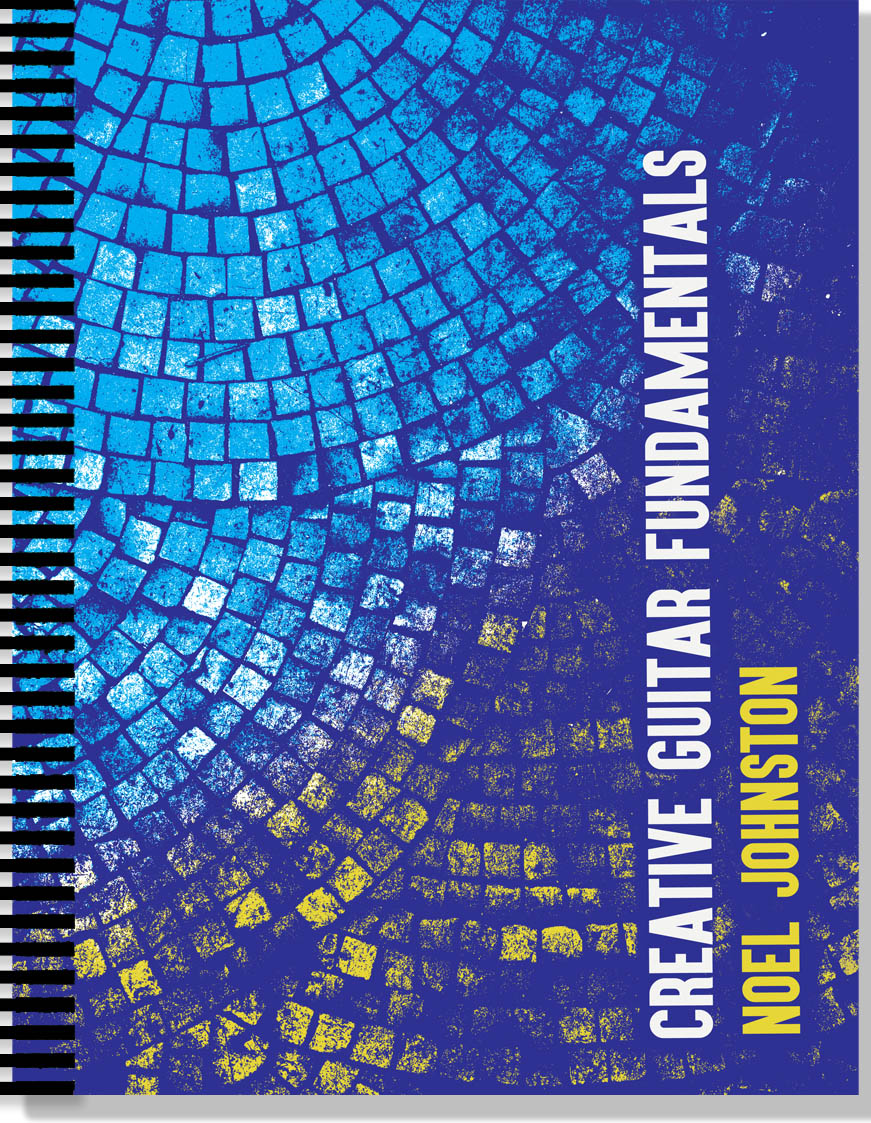
NEW! "Creative Guitar Fundamentals" book (Physical Copy - SPIRAL BOUND) PRE ORDER
Description: Spiral bound! This is a softcover, physical copy of Noel's Creative Guitar Fundamentals texbook. 213 pages. Full of exercises for your hands, ears, eyes & mind. Raw technique, closed triads, open triads, triad arpeggios, inversions, 7th chord voicings and arpeggios, creative arrangments and original compositions designed to help you fill all the holes in your playing.
Price: $34.99
From the introduction: I love to teach. Among the more noble reasons, it makes me a better player. Sometimes I selfishly get to bounce new ideas and techniques off my students, hoping they will find their own way in the process. The content in my previous books, Voicing Modes, Modal Etudes, and The 4-Note Universe, tends to emphasize original thought and creativity rather than fulfilling the typical expectations of what students need in terms of essential skills. This fact became even more obvious to me when a student once told me in his first lesson, “I want to find the holes in my playing.” As he was already a fine musician without any obvious shortcomings, his desire to fill any gaps, I thought, was very wise. Even though he was asking for my opinion, the answer lies not really in my perspective but in a universal truth: the fundamentals. If you ask 100 guitarists to define the “fundamentals” of playing, you’ll likely hear 100 unique answers. To me, fundamentals are the essential tools you wield to give confidence and conviction to your musical ideas. Every guitarist has their own toolkit, shaped by their experiences and mastery of different techniques. The tools at your immediate disposal define how effortlessly you can express yourself through music. Sometimes, our limitations define our sound as we lean into our strengths; however, this can lead to frustration down the road. The mastery and consistent practice of fundamentals makes everything else easier. One of the most successful college basketball coaches, John Wooden, was meticulous about teaching fundamentals. In his book Practical Modern Basketball, he stated, “The team that has the best command of the fundamentals—passing, catching, dribbling, shooting, and defense—will usually win.” Another successful coach, Tom Crean, said, “Game plans win games. Fundamentals win championships.” With Creative Fundamentals, my goal is to systematically equip you with the raw skills needed to become a versatile, well-rounded guitarist (with examples for application along the way via compositions and etudes). Through a blend of pure technical exercises for your hands, ear-hand coordination to sharpen your musical intuition, eye-hand coordination to navigate both the visual symbols of music and the fretboard’s symmetry with precision, and mind-hand coordination to unlock the creative potential that analysis can provide, this book offers both the knowledge and a clear game plan. Whether you’re a beginner or a seasoned player, these exercises will help you identify your weaknesses, build a strong foundation, and expand your ability to make music with confidence and conviction. Practicing fundamentals doesn’t have to be mundane. In this book, I share creative approaches to mastering essential skills, transforming routine practice into ideas for composition. By thinking like a composer, you’ll learn to weave technical proficiency into musical ideas that turn the routine into something fun and interesting. My hope is that Creative Fundamentals not only fills the gaps in your playing but also sparks new ways to express your unique voice as a musician. Throughout this book, I’ll try to help you master the fundamentals not just in terms of technique, but how to access that technique: by ear, by eye and by mind.
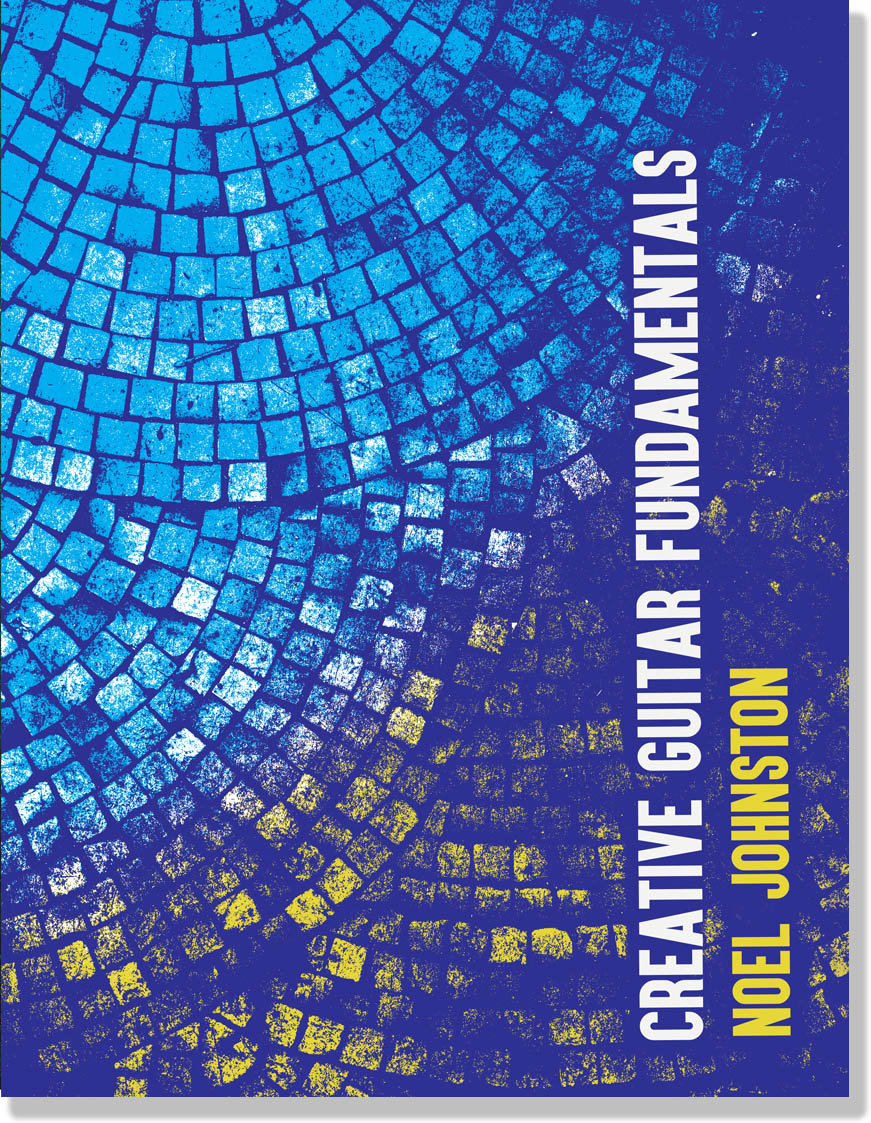
NEW! "Creative Guitar Fundamentals" book (Physical Copy)
Description: This is a softcover, physical copy of Noel's Creative Guitar Fundamentals texbook directly from Amazon. Note: Amazon book is NOT spiral bound and “As an Amazon Associate, I earn from qualifying purchases”
Price: $29.99
From the introduction: I love to teach. Among the more noble reasons, it makes me a better player. Sometimes I selfishly get to bounce new ideas and techniques off my students, hoping they will find their own way in the process. The content in my previous books, Voicing Modes, Modal Etudes, and The 4-Note Universe, tends to emphasize original thought and creativity rather than fulfilling the typical expectations of what students need in terms of essential skills. This fact became even more obvious to me when a student once told me in his first lesson, “I want to find the holes in my playing.” As he was already a fine musician without any obvious shortcomings, his desire to fill any gaps, I thought, was very wise. Even though he was asking for my opinion, the answer lies not really in my perspective but in a universal truth: the fundamentals. If you ask 100 guitarists to define the “fundamentals” of playing, you’ll likely hear 100 unique answers. To me, fundamentals are the essential tools you wield to give confidence and conviction to your musical ideas. Every guitarist has their own toolkit, shaped by their experiences and mastery of different techniques. The tools at your immediate disposal define how effortlessly you can express yourself through music. Sometimes, our limitations define our sound as we lean into our strengths; however, this can lead to frustration down the road. The mastery and consistent practice of fundamentals makes everything else easier. One of the most successful college basketball coaches, John Wooden, was meticulous about teaching fundamentals. In his book Practical Modern Basketball, he stated, “The team that has the best command of the fundamentals—passing, catching, dribbling, shooting, and defense—will usually win.” Another successful coach, Tom Crean, said, “Game plans win games. Fundamentals win championships.” With Creative Fundamentals, my goal is to systematically equip you with the raw skills needed to become a versatile, well-rounded guitarist (with examples for application along the way via compositions and etudes). Through a blend of pure technical exercises for your hands, ear-hand coordination to sharpen your musical intuition, eye-hand coordination to navigate both the visual symbols of music and the fretboard’s symmetry with precision, and mind-hand coordination to unlock the creative potential that analysis can provide, this book offers both the knowledge and a clear game plan. Whether you’re a beginner or a seasoned player, these exercises will help you identify your weaknesses, build a strong foundation, and expand your ability to make music with confidence and conviction. Practicing fundamentals doesn’t have to be mundane. In this book, I share creative approaches to mastering essential skills, transforming routine practice into ideas for composition. By thinking like a composer, you’ll learn to weave technical proficiency into musical ideas that turn the routine into something fun and interesting. My hope is that Creative Fundamentals not only fills the gaps in your playing but also sparks new ways to express your unique voice as a musician. Throughout this book, I’ll try to help you master the fundamentals not just in terms of technique, but how to access that technique: by ear, by eye and by mind.
J.S. Bach Partita no.1 for Electric Guitar

"J.S.Bach Partita no.1 for Electric Guitar" eBook (pdf download)
Description: This is an electronic copy (pdf) of Noel's arrangements/transcriptions on the recently recorded Johann Sebastian Bach Partita no.1 for solo violin arranged for electric guitar. You'll get an instant email with download link. 8 pieces & video links. TAB and no-TAB versions both contained within the ebook
Price: $10.00
Here are the 8 movements in J.S. Bach’s Partita No. 1 in B minor (BWV 1002) - reimagined as if Bach intended it for electric guitar - and as recorded by Noel Johnston For more information on this method of arranging, check out this article: https://www.premierguitar.com/jim-halls-classical-chord-melodies YouTube playlist of these pieces: https://www.youtube.com/playlist?list=PLsDGkdnayoE0WISE_oA0fS3_ht8hy4Bqd J.S. Bach has amassed some of the greatest order of notes ever assembled. I arranged them as if Bach intended them to be played on a Fender Telecaster. It’s a “you should be proud to play electric guitar” record instead of carrying the typical shame that electric guitarists experience in some styles of music - as an inferior piano and an inferior horn bastardized into one peasant’s instrument. My goal here for people to experience this most- beautiful and timeless music while also enjoying the electric guitar. Arranged as if Bach intended it that way! ---- Some reviews of these arrangements taken via YouTube comments: “Beautiful. I like the use of double stops. This body of work you’re compiling is demonstrating the electric guitar as more than a novelty. It is showing it as an entirely legitimate instrument for interpreting this music. Also the use of a pick rather than fingers distinguishes it from classical guitar comparisons. I’m mesmerized by it which is the effect Bach is supposed to have.” “If we could go back in time and show Leo Fender this video, I would love to see his “Guitar Builder Reacts!” video:) This is masterful and musical; with oodles of thoughtful and creative fingering choices and delightful open strings that add to the uniqueness of this rendition. What an accomplishment for this guitarist to have learned this, and for the guitar community to have this. Bach on!” “If Bach only could hear how wonderful his works sound played by you with the electric guitar!” ----
The 4-Note Universe
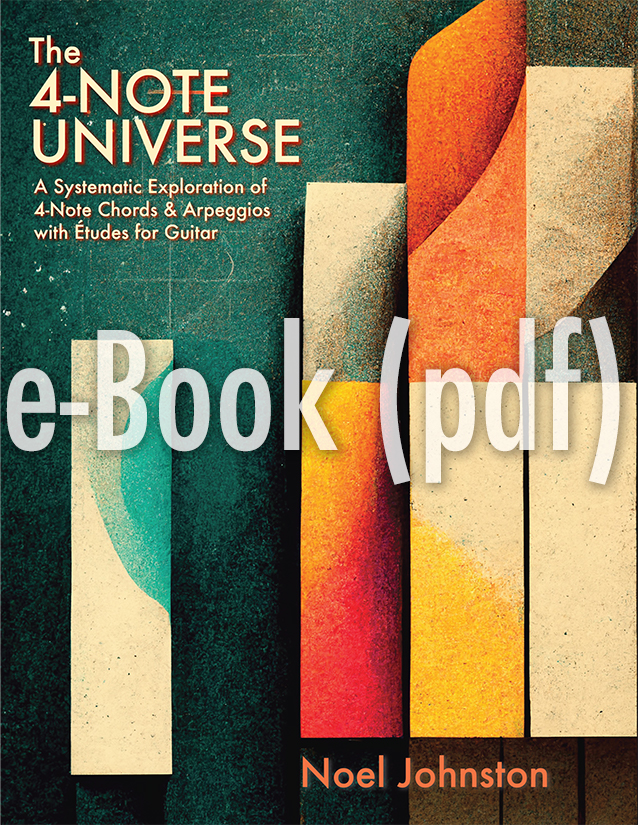
"The 4-Note Universe" eBook (pdf download)
Description: This is an electronic copy (pdf) of the 4-Note Universe book. You'll get an instant email with download link. Full color with audio & video links. 332 pages of exploration. ALL the 4-note chords & arpeggios.
Price: $25.00
A systematic exploration of all 165 4-note chords & arpeggios. in 43 groups. With 43 etudes (duets). Links to audio files & videos provided. INTRODUCTION In a 12-Note system, there are 2047 chord types. 165 of them are 4-note sets (43 if you ignore inversions). When it comes to 4-note sets, most of us have heard of 7th chords: 1-3-5-7. Improvising musicians have explored the typical seventh chord arpeggios and voicings (∆7, Dom7, mi7, mi7(♭5) and °7) as an integral part of mastering both chord theory and their instruments. If you include inversions, those 5 chord types make up only 17 of the possible 165 4-note sets. The systematic study of the remaining sets will give you a firmer grasp on the sounds that are possible, even when those sounds are difficult to label under traditional chord nomenclature. Exploring these alternative chords and arpeggios can yield interesting new sounds and, if mastered, can lead to a unique writing and improvising vocabulary. As you practice and gain familiarity with these new sounds, you’ll be able to: a) have quicker recognition of these sounds when you hear/see/think about them, and b) have greater access to these sounds on your instrument when you hear/see/think about them. Feel free to work sequentially through this book, or to use it as a reference, skipping ahead to whichever types you’d like to explore. There are 5 main categories broken down into 43 groups. Within each group are various arpeggio, chord, and inversion shapes, along with concrete application: their tonal/scale contexts and an étude. Each of the 43 etudes are duets. You can play along with somebody or with the tracks provided, or use a looper pedal and learn both parts. Ultimately, composing your own ideas is the best way to master new sounds... It not only requires that you deeply understand them, but it forces you to physically master whatever it is that you wrote.
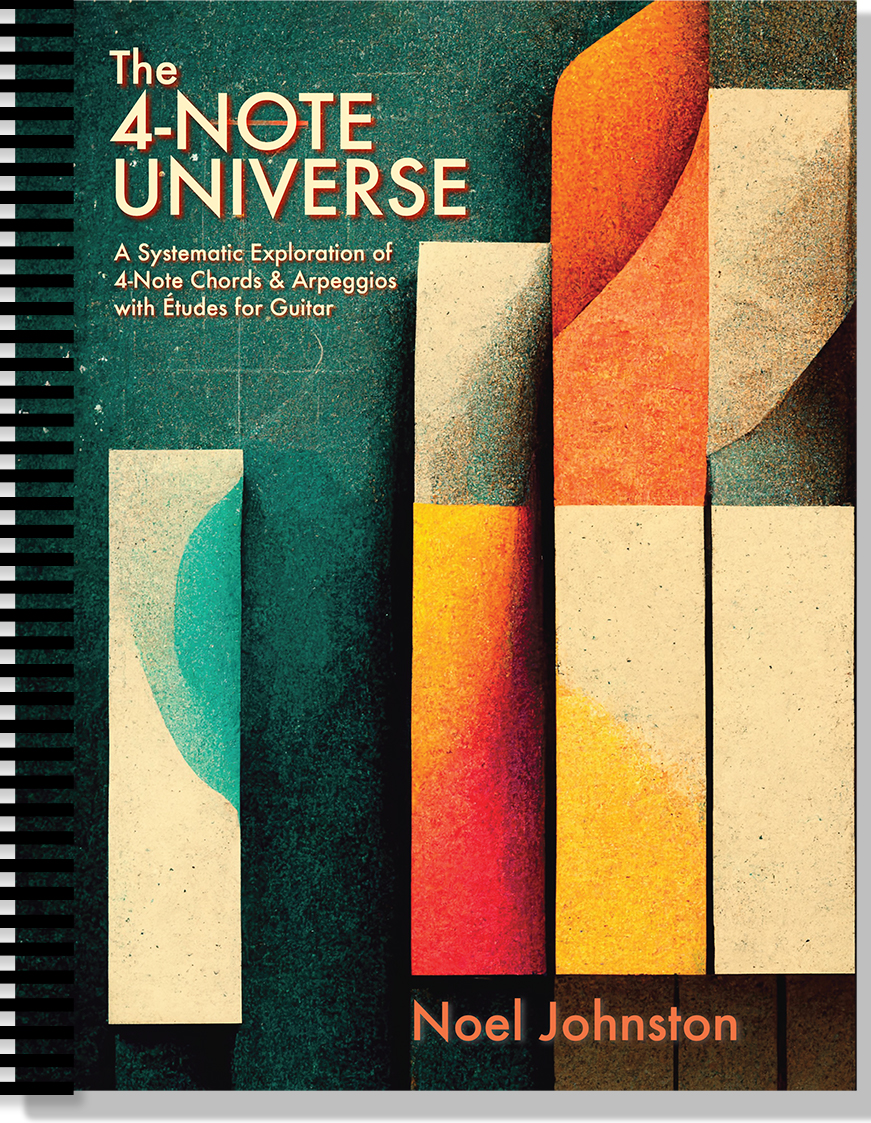
"The 4-Note Universe" book (Physical Copy - SPIRAL BOUND)
Description: Spiral bound! This is a softcover, physical copy of the 4-Note Universe book. With audio & video links. 332 pages of exploration. ALL the 4-note chords & arpeggios.
Price: $44.99
A systematic exploration of all 165 4-note chords & arpeggios. in 43 groups. With 43 etudes (duets). Links to audio files & videos provided. INTRODUCTION In a 12-Note system, there are 2047 chord types. 165 of them are 4-note sets (43 if you ignore inversions). When it comes to 4-note sets, most of us have heard of 7th chords: 1-3-5-7. Improvising musicians have explored the typical seventh chord arpeggios and voicings (∆7, Dom7, mi7, mi7(♭5) and °7) as an integral part of mastering both chord theory and their instruments. If you include inversions, those 5 chord types make up only 17 of the possible 165 4-note sets. The systematic study of the remaining sets will give you a firmer grasp on the sounds that are possible, even when those sounds are difficult to label under traditional chord nomenclature. Exploring these alternative chords and arpeggios can yield interesting new sounds and, if mastered, can lead to a unique writing and improvising vocabulary. As you practice and gain familiarity with these new sounds, you’ll be able to: a) have quicker recognition of these sounds when you hear/see/think about them, and b) have greater access to these sounds on your instrument when you hear/see/think about them. Feel free to work sequentially through this book, or to use it as a reference, skipping ahead to whichever types you’d like to explore. There are 5 main categories broken down into 43 groups. Within each group are various arpeggio, chord, and inversion shapes, along with concrete application: their tonal/scale contexts and an étude. Each of the 43 etudes are duets. You can play along with somebody or with the tracks provided, or use a looper pedal and learn both parts. Ultimately, composing your own ideas is the best way to master new sounds... It not only requires that you deeply understand them, but it forces you to physically master whatever it is that you wrote.
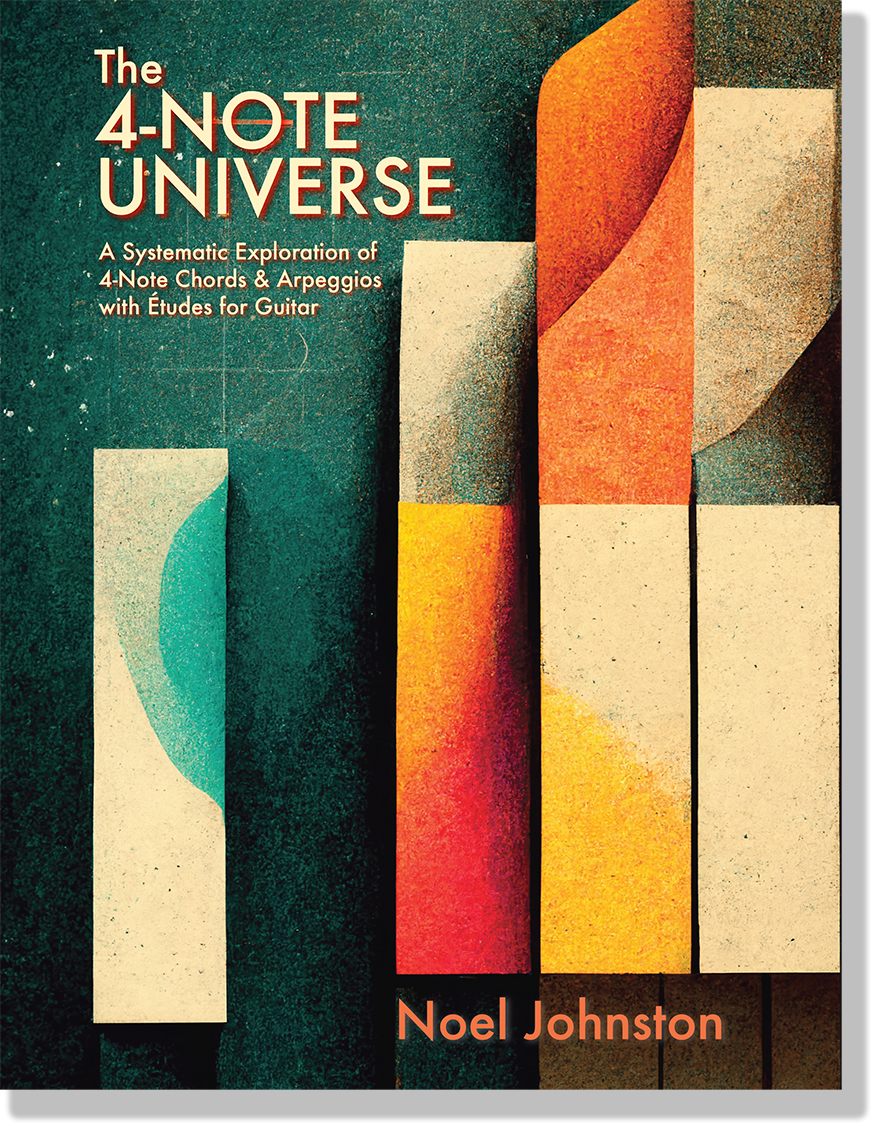
NEW! "The 4-Note Universe" book (Physical Copy)
Description: This is a softcover, physical copy of the 4-Note Universe book. With audio & video links. 332 pages of exploration. ALL the 4-note chords & arpeggios. Note: Amazon book is NOT spiral bound and “As an Amazon Associate, I earn from qualifying purchases”
Price: $39.99

A systematic exploration of all 165 4-note chords & arpeggios. in 43 groups. With 43 etudes (duets). Links to audio files & videos provided. INTRODUCTION In a 12-Note system, there are 2047 chord types. 165 of them are 4-note sets (43 if you ignore inversions). When it comes to 4-note sets, most of us have heard of 7th chords: 1-3-5-7. Improvising musicians have explored the typical seventh chord arpeggios and voicings (∆7, Dom7, mi7, mi7(♭5) and °7) as an integral part of mastering both chord theory and their instruments. If you include inversions, those 5 chord types make up only 17 of the possible 165 4-note sets. The systematic study of the remaining sets will give you a firmer grasp on the sounds that are possible, even when those sounds are difficult to label under traditional chord nomenclature. Exploring these alternative chords and arpeggios can yield interesting new sounds and, if mastered, can lead to a unique writing and improvising vocabulary. As you practice and gain familiarity with these new sounds, you’ll be able to: a) have quicker recognition of these sounds when you hear/see/think about them, and b) have greater access to these sounds on your instrument when you hear/see/think about them. Feel free to work sequentially through this book, or to use it as a reference, skipping ahead to whichever types you’d like to explore. There are 5 main categories broken down into 43 groups. Within each group are various arpeggio, chord, and inversion shapes, along with concrete application: their tonal/scale contexts and an étude. Each of the 43 etudes are duets. You can play along with somebody or with the tracks provided, or use a looper pedal and learn both parts. Ultimately, composing your own ideas is the best way to master new sounds... It not only requires that you deeply understand them, but it forces you to physically master whatever it is that you wrote.
Voicing Modes
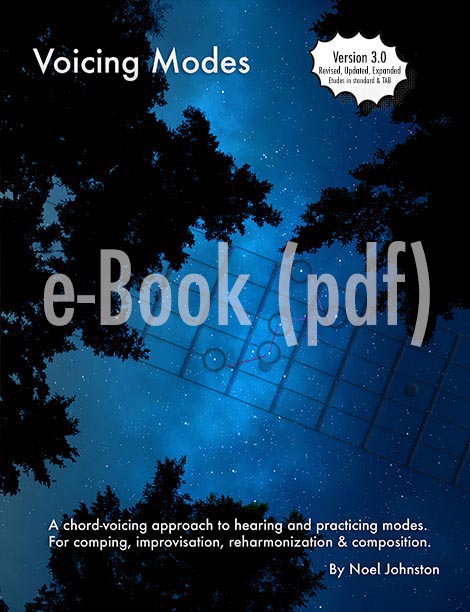
"Voicing Modes" eBook (pdf download)
Description: This is an electronic copy (pdf) of the Voicing Modes book (the latest version, 3rd edition). You'll get an instant email with download link. Full color!
Price: $10.00
Voicing Modes is a book for all guitar players who want to master their modal comprehension and ability. Focuses on a chord-voicing approach to hearing and practicing modes. For comping, improvisation, reharmonization & composition. With detailed explanations, reference material, tune examples, and 12 modal etudes. 181 pages. YouTube links for performance examples available. For a free sample, download link available on this page.
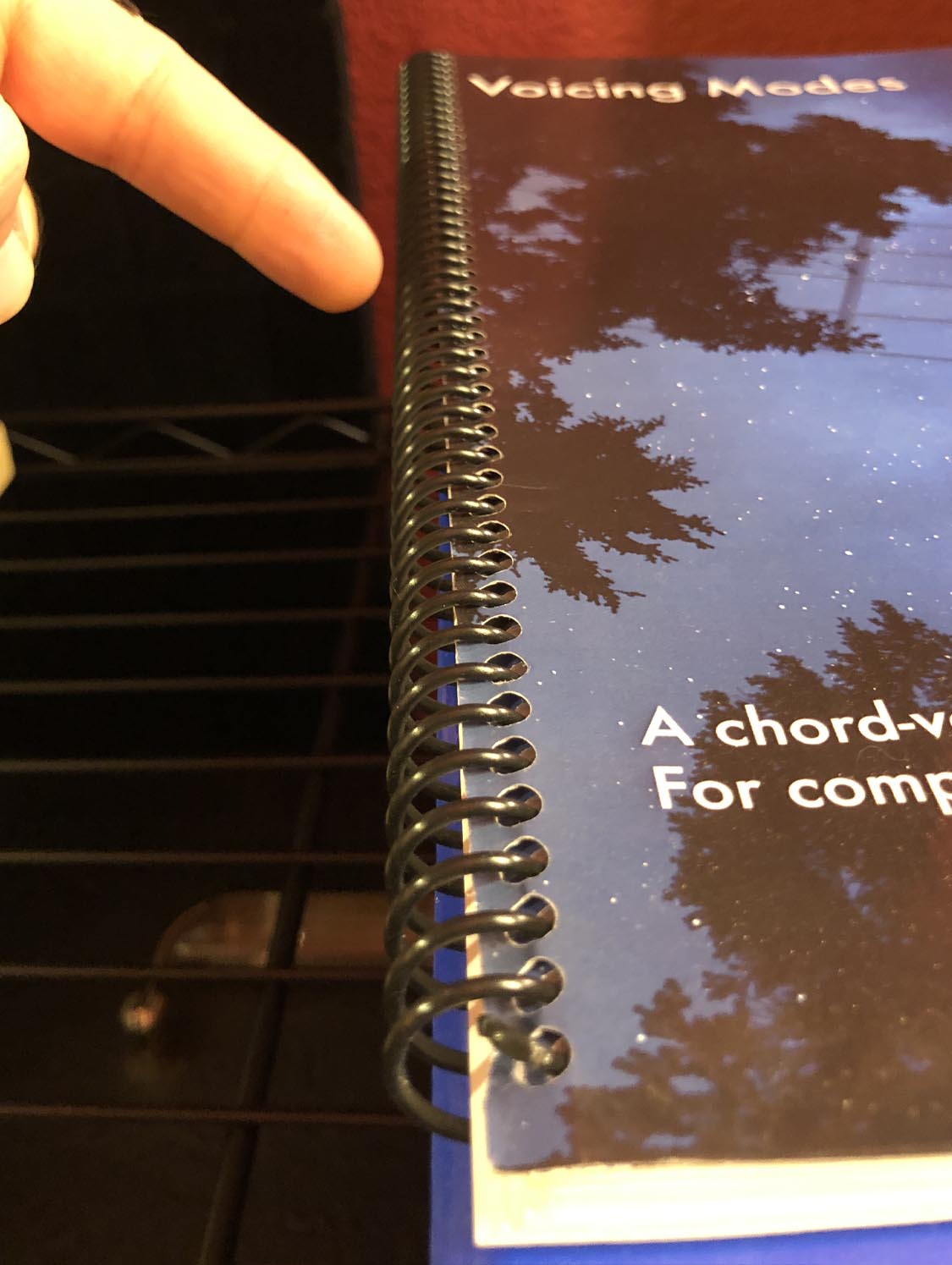
Voicing Modes (Physical copy) book with spiral binding
Description: Upgrade to Spiral binding. This makes reading on a music stand much easier!
Price: $24.99
Voicing Modes book (3rd edition) but with Spiral or Comb binding option. To get the most out of this book, you'll want to learn the etudes, the arpeggio, scale and chord shapes and that means putting it on a music stand. It's easier with spiral or comb binding. (spiral binding pictured) For a free sample of the book, download link available on this page.
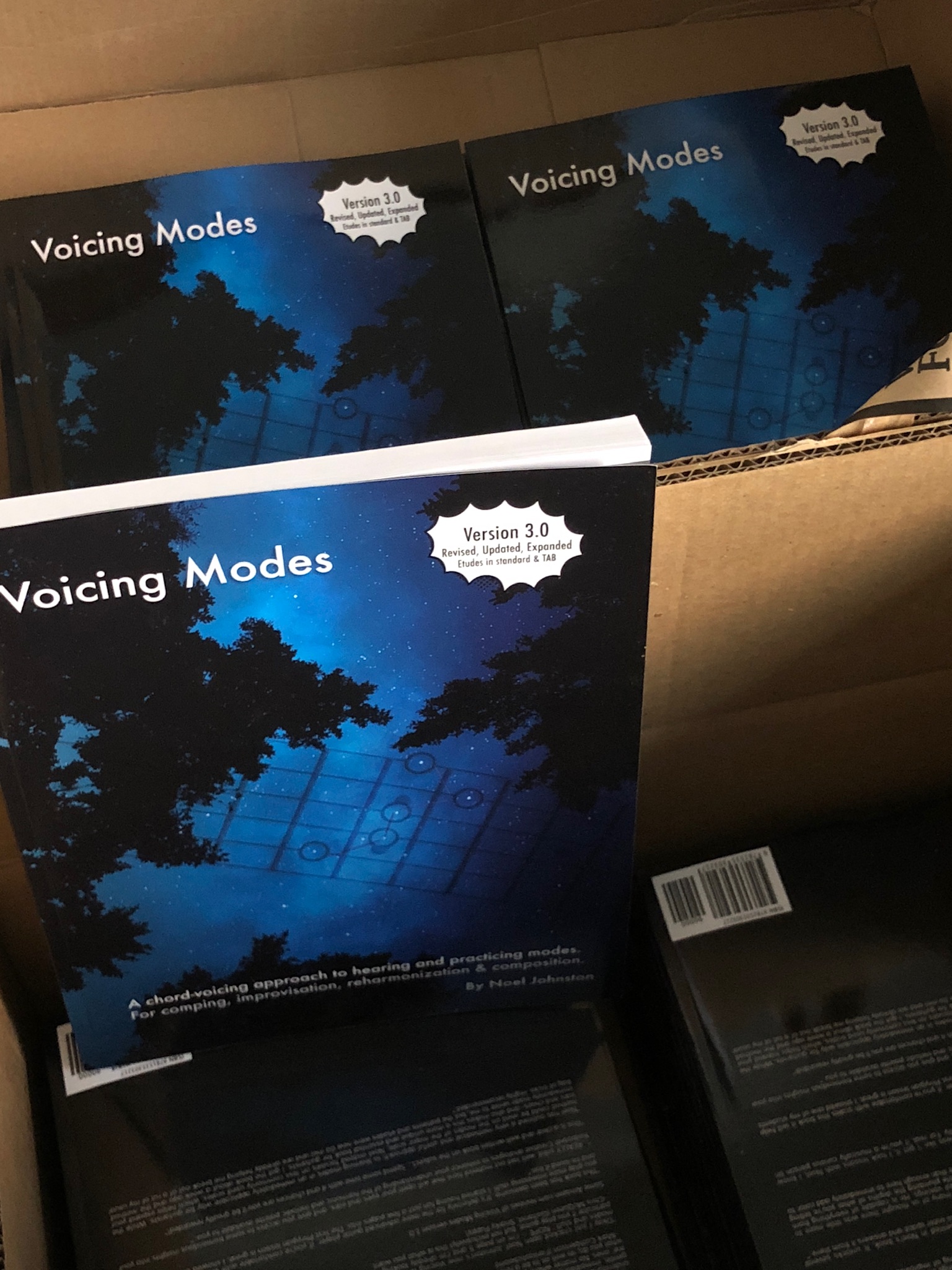
"Voicing Modes" Book (Physical Copy)
Description: Softcover copy of the Voicing Modes book directly from Amazon. Note: Amazon book is NOT spiral bound and “As an Amazon Associate, I earn from qualifying purchases”
Price: $19.99

The latest edition. (3rd edition) Voicing Modes is a book for all guitar players who want to master their modal comprehension and ability. Focuses on a chord-voicing approach to hearing and practicing modes. For comping, improvisation, reharmonization & composition. With detailed explanations, reference material, tune examples, and 12 modal etudes. 181 pages. YouTube links for performance examples available. For a free sample of the book, download link available on this page.
Modal Etudes
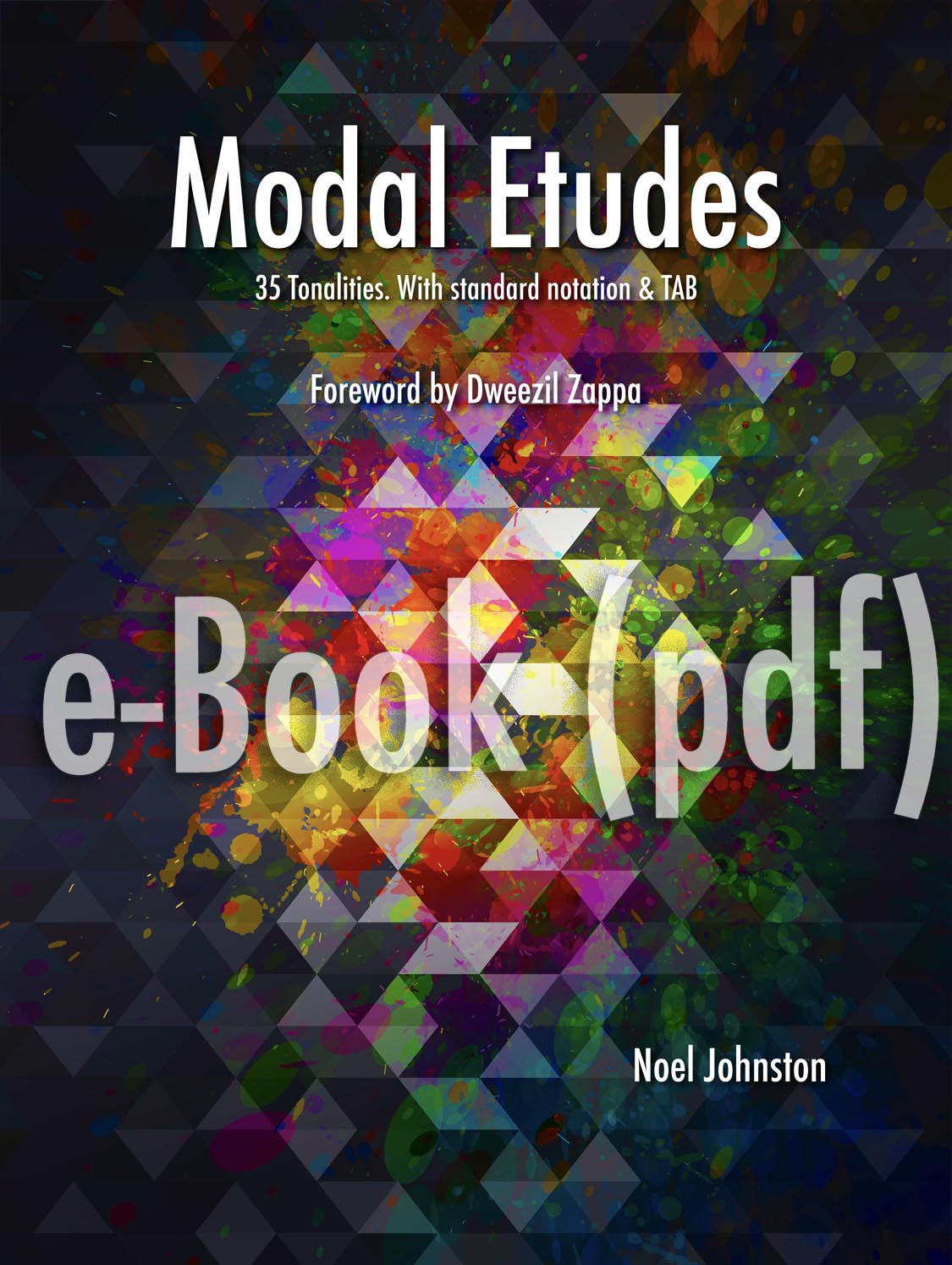
"Modal Etudes" eBook (pdf download)
Description: This is an electronic copy (pdf) of the Modal Etudes book with standard notation & TAB. You'll get an instant email with download link.
Price: $10.00
36 etudes in 35 tonalities. From the Foreword by Dweezil Zappa: "Noel Johnston’s modal dice method reveals all guitarists’ strengths and weaknesses while simultaneously providing fun ways to improve their overall musicality. This is by no means an insipid “Life Hack” guitar book nor is it a judgmental “Theory Wizard” treatise. This is a comprehensive way to enhance your understanding and appreciation of the modes and what they offer you as a guitarist/musician. If you have ever found yourself saying, “I wish there was a way that I could identify and understand why I like the sounds I hear in music” then this book is for you. Use it to your advantage and make the best music you can make. Thank Noel when you see him!"
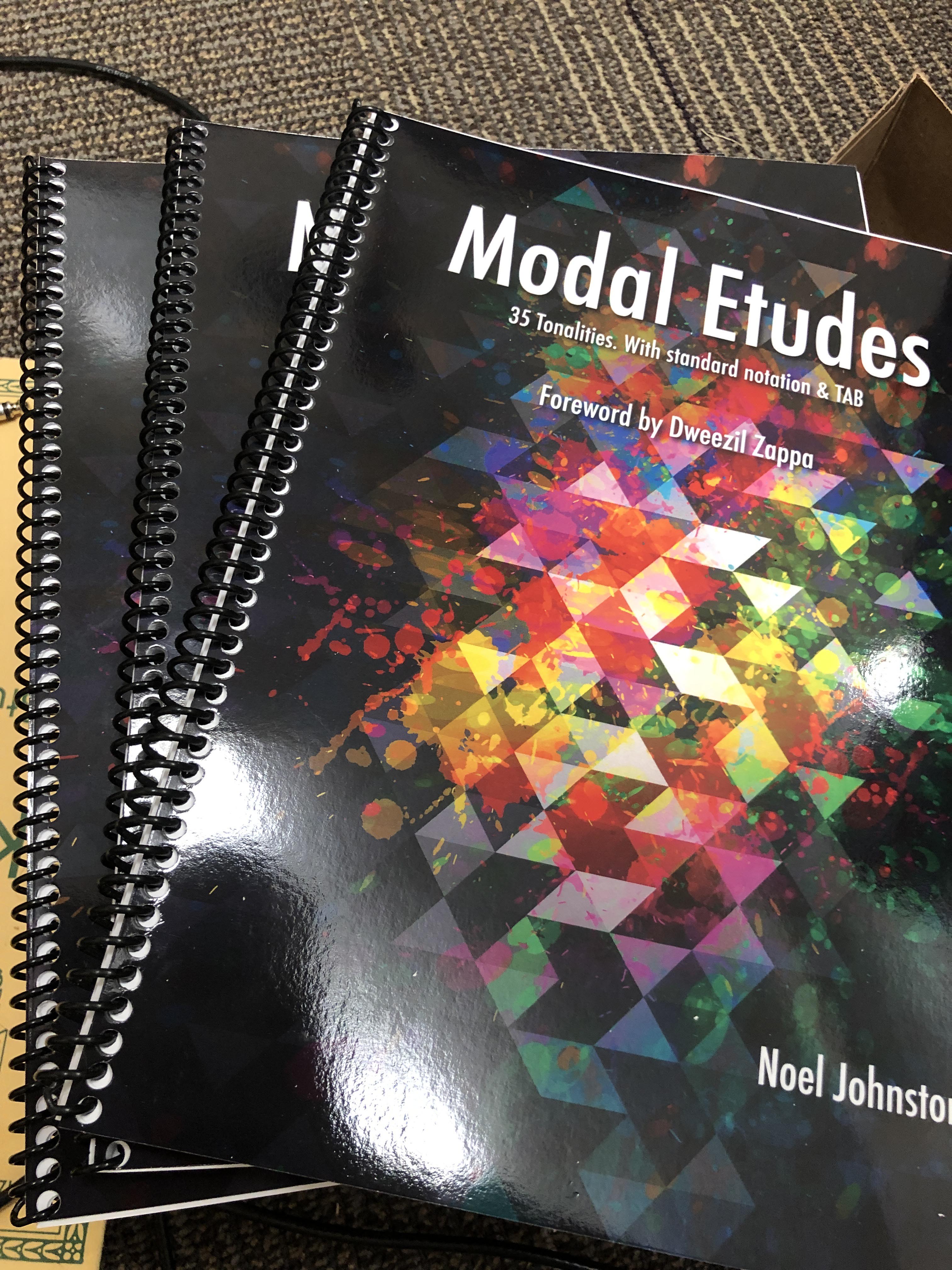
"Modal Etudes" -with TAB- (Spiral Bound)
Description: Upgrade to Spiral binding. This makes reading on a music stand much easier!
Price: $21.99
36 short etudes in 35 tonalities. From the Foreword by Dweezil Zappa: "Noel Johnston’s modal dice method reveals all guitarists’ strengths and weaknesses while simultaneously providing fun ways to improve their overall musicality. This is by no means an insipid “Life Hack” guitar book nor is it a judgmental “Theory Wizard” treatise. This is a comprehensive way to enhance your understanding and appreciation of the modes and what they offer you as a guitarist/musician. If you have ever found yourself saying, “I wish there was a way that I could identify and understand why I like the sounds I hear in music” then this book is for you. Use it to your advantage and make the best music you can make. Thank Noel when you see him!"
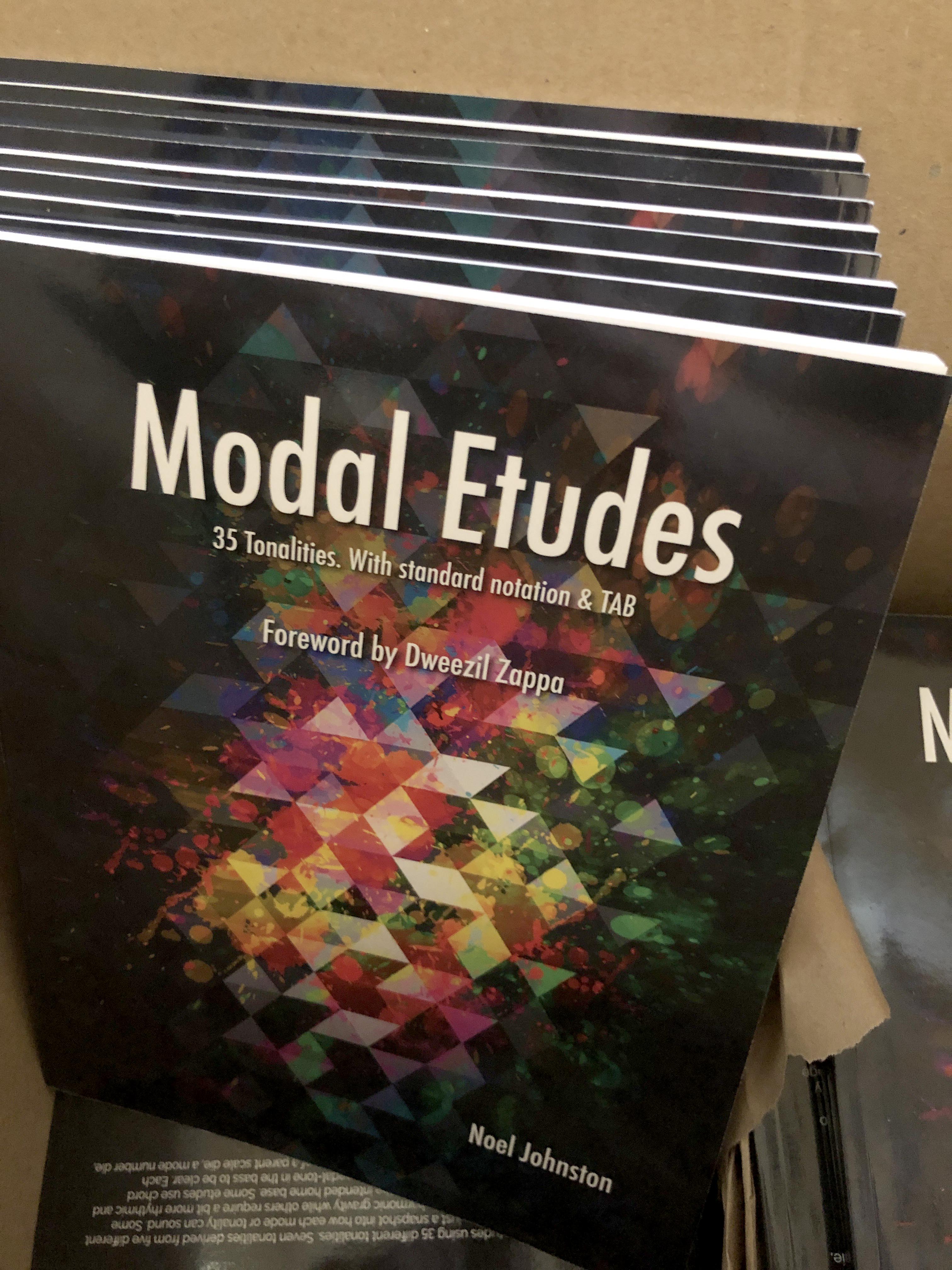
Modal Etudes -with TAB- (Physical copy)
Description: Soft-cover, physical copy of the Modal Etudes book. (Standard notation & TAB). Order directly from Amazon. Note: Amazon book is NOT spiral bound and “As an Amazon Associate, I earn from qualifying purchases”
Price: $16.99

36 short etudes in 35 tonalities. From the Foreword by Dweezil Zappa: "Noel Johnston’s modal dice method reveals all guitarists’ strengths and weaknesses while simultaneously providing fun ways to improve their overall musicality. This is by no means an insipid “Life Hack” guitar book nor is it a judgmental “Theory Wizard” treatise. This is a comprehensive way to enhance your understanding and appreciation of the modes and what they offer you as a guitarist/musician. If you have ever found yourself saying, “I wish there was a way that I could identify and understand why I like the sounds I hear in music” then this book is for you. Use it to your advantage and make the best music you can make. Thank Noel when you see him!"
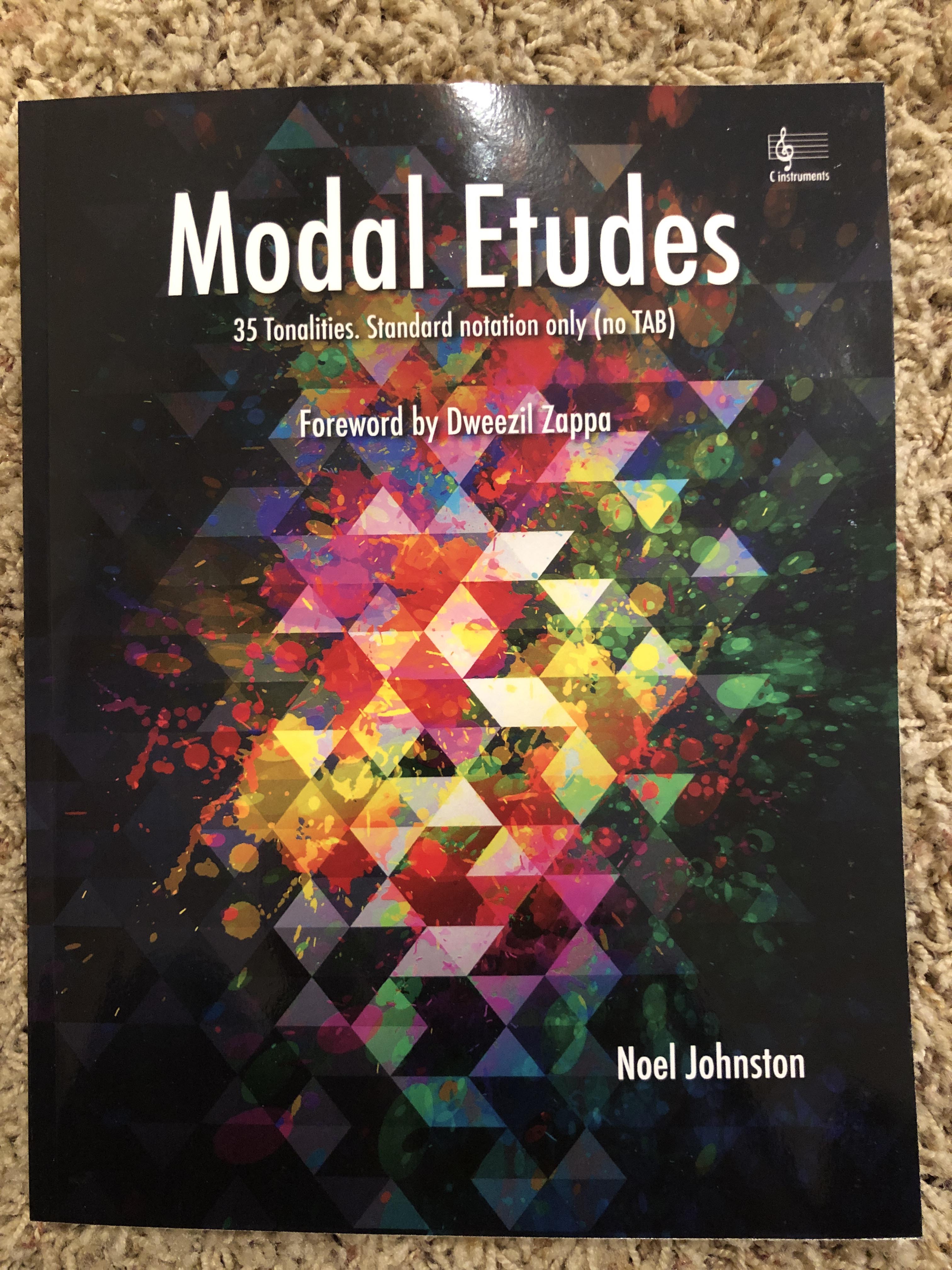
"Modal Etudes" -no TAB- (Physical copy)
Description: Soft-cover, physical copy of the Modal Etudes book. (Standard notation only. No TAB). Order directly from Amazon. Note: Amazon book is NOT spiral bound and “As an Amazon Associate, I earn from qualifying purchases”
Price: $16.99

36 short etudes in 35 tonalities. From the Foreword by Dweezil Zappa: "Noel Johnston’s modal dice method reveals all guitarists’ strengths and weaknesses while simultaneously providing fun ways to improve their overall musicality. This is by no means an insipid “Life Hack” guitar book nor is it a judgmental “Theory Wizard” treatise. This is a comprehensive way to enhance your understanding and appreciation of the modes and what they offer you as a guitarist/musician. If you have ever found yourself saying, “I wish there was a way that I could identify and understand why I like the sounds I hear in music” then this book is for you. Use it to your advantage and make the best music you can make. Thank Noel when you see him!"
Sold Out Items
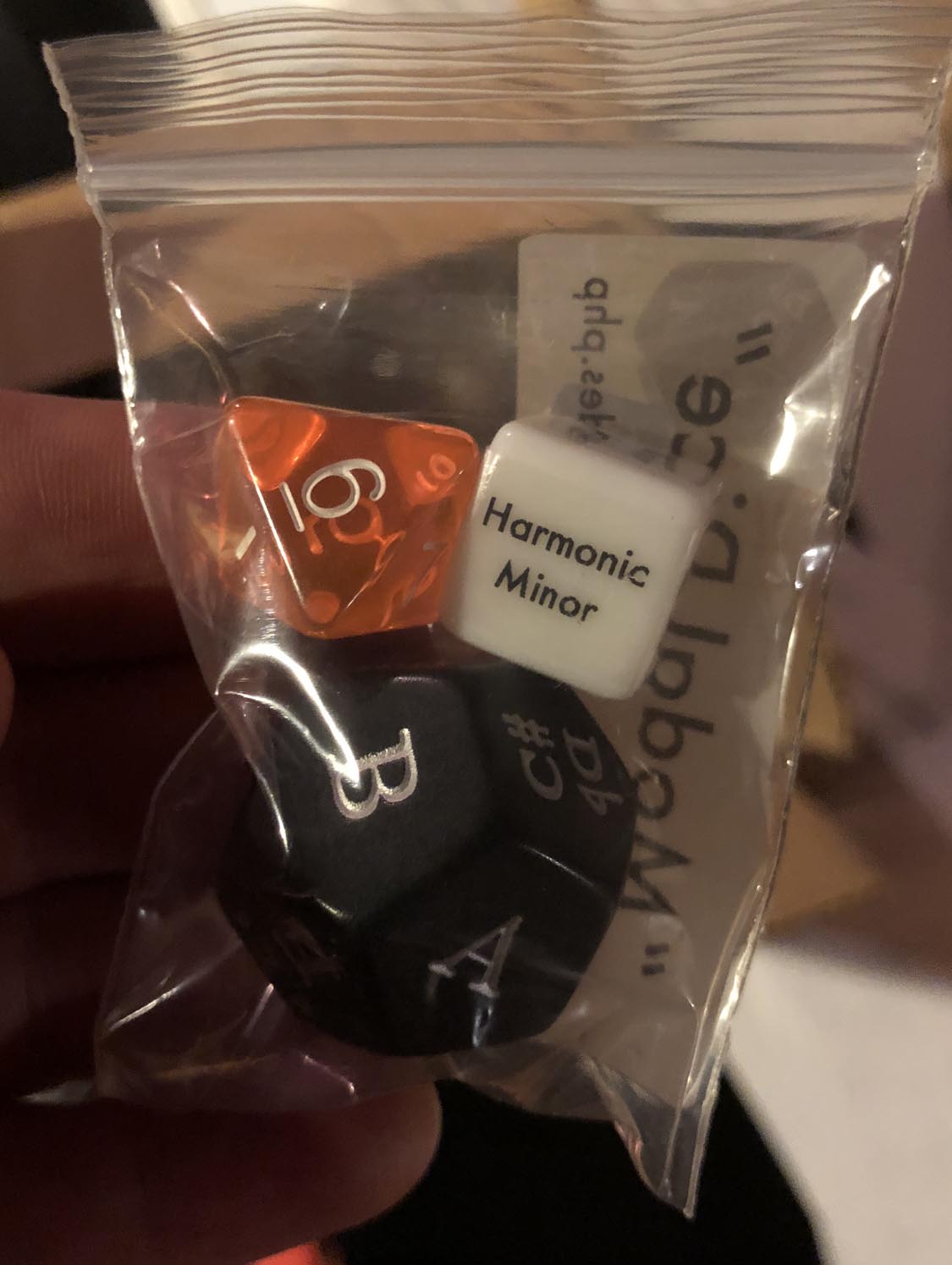
Modal Dice
Description: Set of 3 dice: one for parent scale (6-sided), one for the mode (8-sided), one for pitch (12-sided)
Price: Sold out. Meanwhile, here's a digital version: https://www.noeljohnston.com/modal-dice.html
Mix up your practice session. Compose or arrange with this set. The 6-sided die has the parent scale options (Major scale, Harmonic minor, Melodic minor, Harmonic major, and Hungarian minor, as well as 'synthetic/symmetrical' option), the 8-sided die indicated the mode (8 would usually mean "roll again"), and the 12-sided die indicates the pitch. For example if you roll "3/Melodic Minor/Bb" that would indicate "Bb Lydian-Augmented" (3rd mode of Melodic Minor starting on Bb). Check out the Voicing Modes Web App for for some possibilities!
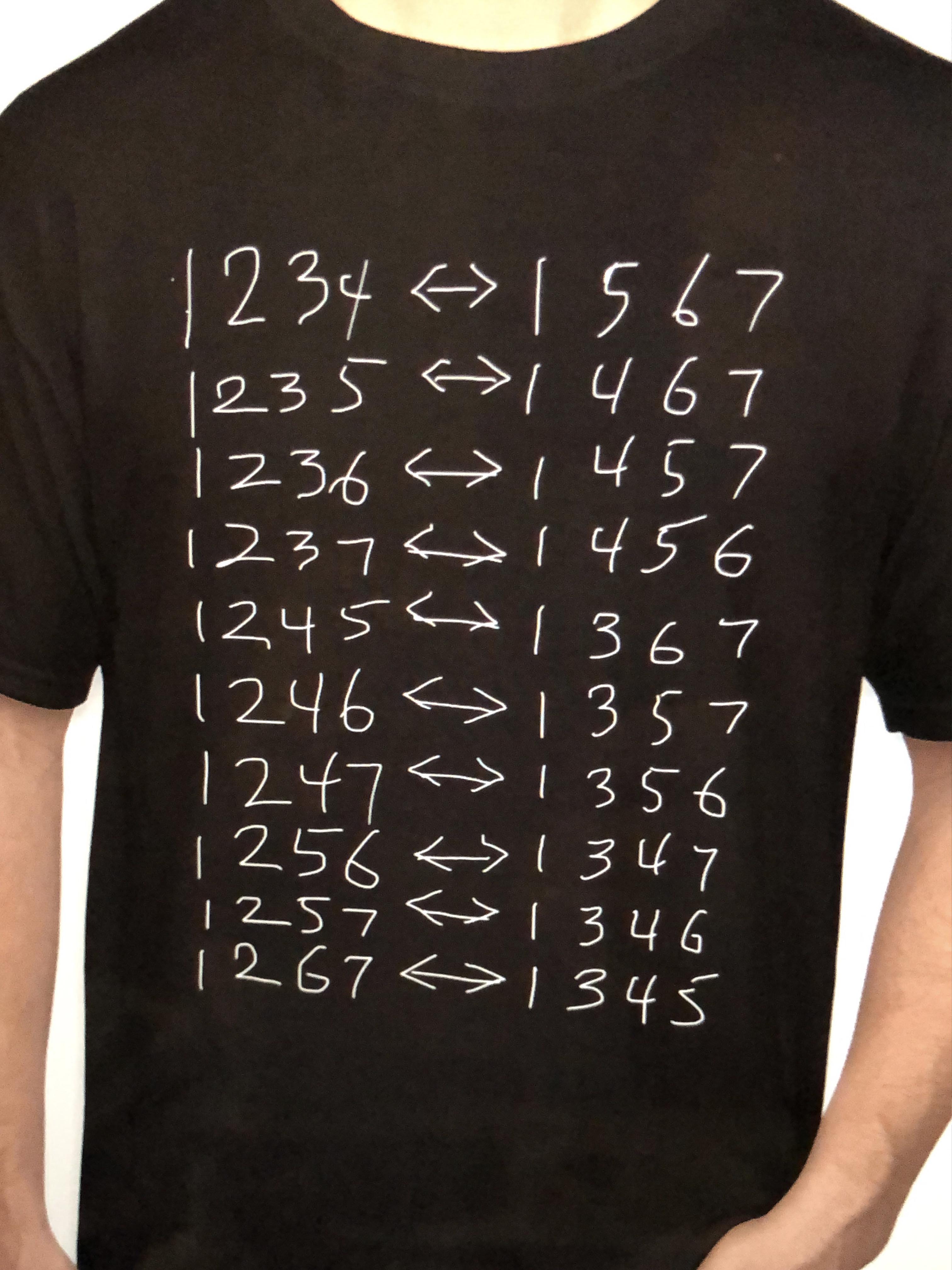
20 4-note sets T-Shirt
Description: High fashion, conversation starter and compositional inspiration
Price: Sold out
"I talk about this stuff at parties!". Let's face it. You know you got into playing guitar because of the girls, but now that you are married it'll be easy to stay faithful with this uber-nerdy (and non-political) fashion statement, sure to fend off all those pesky fusion gold-diggers. If a cutey asks you "what do all these numbers mean?" and you open your mouth to explain and if she seems interested after 30 seconds, you'd better watch out! Put that beer down and go straight to church. You can all but guarantee that she is lying and/or she plays waaaay better than you. 100% cotton.